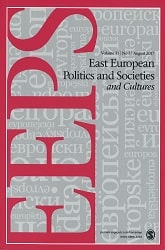The Socialist Housing Projects as Non-Places in Post-2000 Polish Literary and Cinematic Narratives
The Socialist Housing Projects as Non-Places in Post-2000 Polish Literary and Cinematic Narratives
Author(s): My SvenssonSubject(s): Cultural history, Architecture, Polish Literature, Transformation Period (1990 - 2010), Film / Cinema / Cinematography, Sociology of Art
Published by: SAGE Publications Ltd
Keywords: non-places; heterotopia; supermodernity; Polish contemporary literature and cinema; housing projects; blokowisko;
Summary/Abstract: Beginning approximately a decade after the fall of the Berlin Wall, a cultural wave of various artistic representations of the socialist housing projects (blokowisko in Polish) arose in Poland. Three such works, Krzysztof Bizio’s short story collection Zresztą latem wszystkie kwiaty są takie piękne [Besides, in Summer All Flowers are Beautiful] (2003), Robert Gliński’s feature film Cześć, Tereska [Hi, Tereska] (2001), and Sylwester Latkowski’s documentary Blokersi (2001), well illustrate this new cultural trend. A common feature of these works is the complete absence of cultural or national landmarks; the life of the protagonists revolves around the housing projects and the non-places of supermodernity. The atmosphere in the stories ranges from gloom to darkness and their endings are usually unresolved or tragic. However, despite the despair and even fatalism surrounding especially the young female characters, all of the protagonists manage to find spaces of refuge, where they can unlock their imagination. Drawing on Marc Auge’s study of the non-places of supermodernity and Michel Foucault’s concept of heterotopia, while comparing the works to the contemporaneous Swedish film Lilya 4-Ever (2001), this article emphasizes the transnational character of the blokowisko and its universal meaning as a non-place.
Journal: East European Politics and Societies
- Issue Year: 26/2012
- Issue No: 03
- Page Range: 469-485
- Page Count: 17
- Language: English
- Content File-PDF

